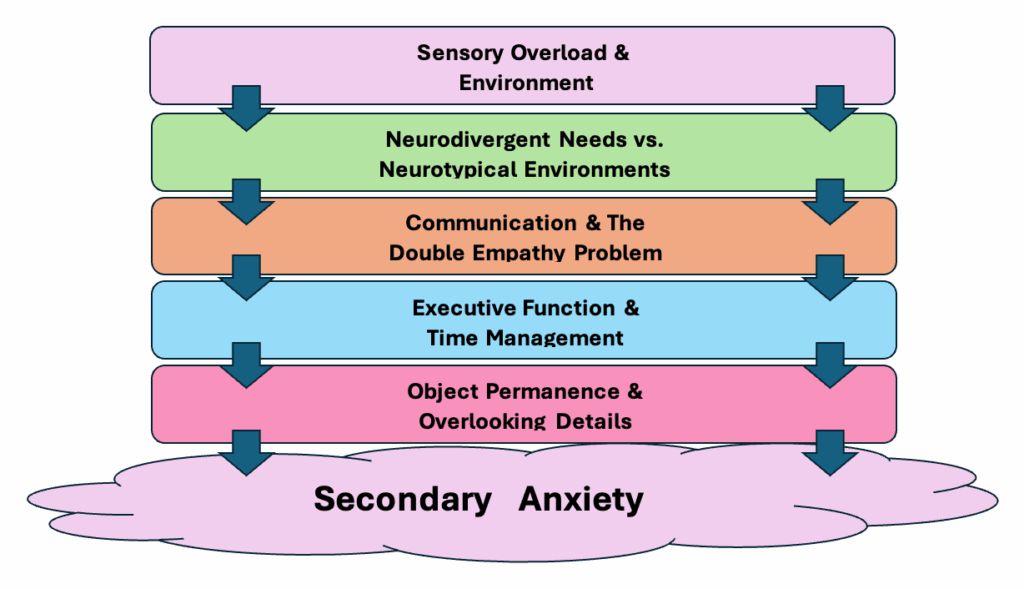As parents and carers, we know that anxiety isn’t just an occasional worry for our neurodivergentAn individual whose brain functions differently from the (usually neurotypical) perception of what is “normal”. For example, an individual with autism, Asperger's syndrome, dyslexia, dyscalculia, dyspraxia, ADHD, OCD or Tourette Syndrome. children—it’s often a constant thread running through daily life. You might see it surface during homework time, at the school gates, or when a familiar routine suddenly changes.
But what if this anxiety is an understandable, and even expected, response to navigating an ecosystem not designed for how their brains work? This is the core of what we call Secondary Anxiety.—where anxiety is not a primary conditionA state of mental or physical health that is considered to be different to pre-defined ‘norms’., but a logical reaction to environmental mismatches and unmet needs, a concept powerfully illustrated in the Pathological Demand Avoidance (PDA) profile of autismA complex developmental condition which can significantly affect verbal and non-verbal communication and social interaction in a range of ways. (PDA Society, 2023).
Understanding the Link: Why Our Children Feel So Anxious
NeurodiversityHow human brains and minds differ. The Neurodiversity Movement is an approach that seeks equal rights, respect and inclusion for neurodivergent people who have conditions like autism, Asperger's syndrome, dyslexia, dyscalculia, dyspraxia, ADHD, OCD or Tourette Syndrome means our children’s brains are wired differently—whether they are Autistic, have ADHD, dyslexiaA condition that involves difficulty in learning to read or interpret letters, words and other symbols., or other neurotypes. Their brains aren’t broken; they are powerful processors that simply operate on an equally effective but on a different operating system.
The challenge—and the source of so much anxiety—arises from the constant friction between their neurotype and the world around them. Navigating schools, social situations, and daily expectations can feel like a constant mismatch. The resulting anxiety is not a personal failing, but a justified stress response—the body’s way of saying, “The demands of this situation are in conflict with my neurotype.”

The diagram above illustrates the weight of these challenges.
When we view their distress through this lens, it becomes clear: their anxiety is not a flaw, but a logical reaction to a poor fit. By shifting our focus from “fixing” the child to adapting their ecosystem, we can begin to ease the pressure and build a world where they can truly thrive.
Our Shared Challenges (And Tried-and-Tested Solutions)
Let’s explore some common situations our community faces, along with simple approaches that have helped many families find more calm in their daily lives.
1. The Mismatch: NeurodivergentAn individual whose brain functions differently from the (usually neurotypical) perception of what is “normal”. For example, an individual with autism, Asperger's syndrome, dyslexia, dyscalculia, dyspraxia, ADHD, OCD or Tourette Syndrome. Needs vs. NeurotypicalThe term given to a group of people or an individual who is not neurodivergent, and who does not have a condition such as Asperger's syndrome, dyslexia, dyscalculia, dyspraxia, ADHD, OCD or Tourette Syndrome. Environments
To truly understand secondary anxiety, it helps to see the specific points of friction. Our neurotypicalThe term given to a group of people or an individual who is not neurodivergent, and who does not have a condition such as Asperger's syndrome, dyslexia, dyscalculia, dyspraxia, ADHD, OCD or Tourette Syndrome. world is built on a set of assumed “standard” skills, but for our children, these expectations can be a minefield of overwhelming demands.
💡 Our Community’s Tip: The “Mismatch Detective
When you see anxiety rising, pause and ask: “What in this environment is not working for you?” Look for the specific mismatch in communication, sensory input, or expectations. Often, simply identifying the friction point is the first step toward finding a solution that works for everyone.
2. When Communication Creates Tension (Communication & The Double Empathy Problem)
The Challenge: We ask our children to “get ready,” only to see them become overwhelmed. Or our child’s honest, direct comments are misunderstood by others.
💡 Our Community’s Tip: “When… Then” Statements
Rather than using open-ended instructions, we frame requests clearly: “When you’ve put your shoes on, then we can watch your favourite programme.” This creates predictable steps that help reduce anxiety for everyone.
3. When Daily Demands Feel Overwhelming (Executive FunctionA set of mental skills that allow us to organise thoughts and activities, prioritise tasks, manage time efficiently, remember instructions, focus attention, and make decisions. & Time Management)
The Challenge: Managing school bags, homework, appointments and meals can feel like an impossible task – especially during busy mornings.
💡 Our Community’s Tip: The Family “Launch Pad”
We place a large basket or box by the front door where every family member (parents included!) places tomorrow’s essentials each evening. This simple system prevents those frantic morning searches.
4. When Home Doesn’t Feel Peaceful (Sensory Overload & Environment)
The Challenge: Our living spaces can become overwhelming with bright lights, constant noise and clutter. For neurodivergentAn individual whose brain functions differently from the (usually neurotypical) perception of what is “normal”. For example, an individual with autism, Asperger's syndrome, dyslexia, dyscalculia, dyspraxia, ADHD, OCD or Tourette Syndrome. family members, this isn’t merely irritating – it can be genuinely distressing.
💡 Our Community’s Tip: Create a “Calm Corner”
We designate a small area with soft lighting, comfortable seating and noise-reducing headphones where any family member can take a quiet break when feeling overwhelmed.
5. When Important Things Go Missing (Object Permanence & Overlooking Details)
The Challenge: Permission slips disappear, homework is forgotten, and keys seem to vanish. This relates to how our brains process what we can’t immediately see.
💡 Our Community’s Tip: Build a “Visual Management System
We use a large family whiteboard for important reminders and open baskets or clear containers for daily items. Making things visible helps our brains remember what matters.
Remember: We’re Not Failing – We’re Learning New Ways
The truth is, we’re navigating systems that weren’t designed with our families’ wonderful neurodivergentAn individual whose brain functions differently from the (usually neurotypical) perception of what is “normal”. For example, an individual with autism, Asperger's syndrome, dyslexia, dyscalculia, dyspraxia, ADHD, OCD or Tourette Syndrome. brains in mind. The challenges we face aren’t evidence of failure – they’re signs that we need different tools and approaches.
Finding Our Way Forward Together
We’ve developed “Looking beyond the Diagnosis” – a welcoming Group Coaching Workshop created specifically for families like ours. It’s a space where you can:
- Connect with other parents who truly understand
- Learn practical strategies that work with neurodivergentAn individual whose brain functions differently from the (usually neurotypical) perception of what is “normal”. For example, an individual with autism, Asperger's syndrome, dyslexia, dyscalculia, dyspraxia, ADHD, OCD or Tourette Syndrome. brains
- Share experiences and solutions in a supportive environment
- Find validation and new perspectives
Whether you’re neurodivergentAn individual whose brain functions differently from the (usually neurotypical) perception of what is “normal”. For example, an individual with autism, Asperger's syndrome, dyslexia, dyscalculia, dyspraxia, ADHD, OCD or Tourette Syndrome. yourself, parenting neurodivergentAn individual whose brain functions differently from the (usually neurotypical) perception of what is “normal”. For example, an individual with autism, Asperger's syndrome, dyslexia, dyscalculia, dyspraxia, ADHD, OCD or Tourette Syndrome. children, or both – you’ll find understanding and practical support in our community.
Workshop Details:
Date : November 27th
Time : 12pm – 1.30pm
Online – via zoom
Cost : £35
Sign up here – https://buy.stripe.com/7sY6oH3u20qr55w9lbeIw02






